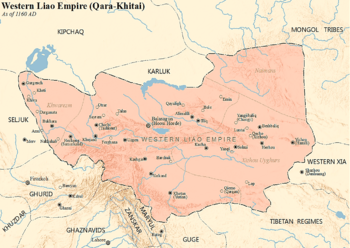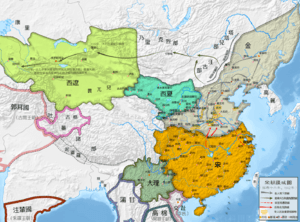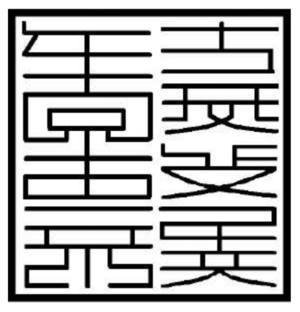Qara Khitai facts for kids
Quick facts for kids
Great Liao
大遼
|
|||||||||||||||||||
|---|---|---|---|---|---|---|---|---|---|---|---|---|---|---|---|---|---|---|---|
| 1124–1218 | |||||||||||||||||||

Qara Khitai c. 1160
|
|||||||||||||||||||
| Status | Sinicized Khitan empire in Central Asia | ||||||||||||||||||
| Capital | Balasagun | ||||||||||||||||||
| Common languages |
|
||||||||||||||||||
| Religion | |||||||||||||||||||
| Demonym(s) | Kara Khitan | ||||||||||||||||||
| Government | Monarchy | ||||||||||||||||||
| Emperor | |||||||||||||||||||
|
• 1124–1143
|
Emperor Dezong | ||||||||||||||||||
|
• 1144–1150
|
Empress Gantian (regent) | ||||||||||||||||||
|
• 1150–1164
|
Emperor Renzong | ||||||||||||||||||
| Historical era | Middle Ages | ||||||||||||||||||
|
• Fall of Liao dynasty
|
1125 | ||||||||||||||||||
|
• Yelü Dashi proclaims himself king
|
1124 | ||||||||||||||||||
|
• Yelü Dashi adopts the title of Gurkhan
|
1132 | ||||||||||||||||||
|
• Yelü Dashi captures Balasagun and establishes capital
|
1134 | ||||||||||||||||||
|
• Kuchlug usurps power
|
1211 | ||||||||||||||||||
|
• Kuchlug executed by Mongols
|
1218 | ||||||||||||||||||
|
• All former territories fully absorbed into Mongol Empire
|
1220 | ||||||||||||||||||
| Area | |||||||||||||||||||
| 1130 est. | 1,000,000 km2 (390,000 sq mi) | ||||||||||||||||||
| 1210 est. | 1,500,000 km2 (580,000 sq mi) | ||||||||||||||||||
| Currency | cash coins | ||||||||||||||||||
|
|||||||||||||||||||
The Qara Khitai (pronounced Kah-rah Kee-tie) was a powerful empire in Central Asia that existed from 1124 to 1218. It was also known as the Western Liao dynasty. This empire was founded by the Khitan Yelü family. They were a group that had adopted many Chinese customs.
The Qara Khitai empire was a successor to the earlier Liao dynasty. Its founder, Yelü Dashi, led the remaining Khitan people from Manchuria to Central Asia. This happened after the Jin dynasty took over their homeland in northern China. The empire was later taken over by a group called the Naimans in 1211. This was led by Kuchlug. Even though the empire continued for a few more years, many historians see this as its end. The Qara Khitai finally fell when the Mongols conquered it in 1218.
The lands of the Qara Khitai empire included parts of what are now China, Kazakhstan, Kyrgyzstan, Mongolia, Tajikistan, and Uzbekistan. Several other states, like the Anushtegin dynasty and the Kara-Khanid Khanate, were under their control at different times.
Contents
What Was the Qara Khitai Called?

The Qara Khitai empire adopted many features of a Chinese state. They even used the Chinese dynastic name "Great Liao". Because of this, historians from China, Korea, and Japan often call it the "Western Liao". This name shows that they saw it as a continuation of the earlier Liao dynasty.
The name "Qara Khitai" was commonly used by tribes in Central Asia. It is also often used by historians in the West. "Qara" means "black" in Turkish. The original meaning of "Black Khitans" is not fully clear today. In the Mongolian language, "Kara-Khitan" is called "Хар Хятан" (Khar Khyatan).
Since there are no direct records from the Qara Khitai empire itself, all we know comes from other countries. The Jurchens, who were rivals, called the empire "Dashi" or "Dashi Linya". This was after its founder, Yelü Dashi. They did this to avoid giving the Qara Khitai any claim to the old Liao lands. Muslim historians first called the state simply "Khitay" or "Khitai". This word "Khitan" is where the name "Cathay" comes from, which was a foreign name for China in the past.
The Story of the Qara Khitai
How the Empire Began
The Qara Khitai empire was started by Yelü Dashi. He led the Khitan people west across Mongolia after their original Liao dynasty fell apart. The Jurchens, who used to be under Khitan rule, had teamed up with the Song dynasty to overthrow the Liao.
Yelü Dashi gathered an army of Khitans and other tribes. In 1134, they captured Balasagun from the Kara-Khanid Khanate. This event marks the beginning of the Qara Khitai empire in Central Asia. About 10,000 Khitans who were already living under the Kara-Khanid Khanate joined Yelü Dashi's forces.
The Khitans then conquered other cities like Kashgar and Khotan. They defeated the Western Kara-Khanid Khanate in 1137. This gave them control over the Fergana Valley. A big victory for them was the Battle of Qatwan in 1141. They defeated both the Western Kara-Khanids and the Seljuk Empire. This battle allowed the Khitans to control a region called Transoxiana.
Yelü Dashi had hoped to take back northern China from the Jin dynasty. However, he soon realized his empire was not strong enough to defeat the Jin. He gave up this idea after a difficult attack in 1134. Even so, the Western Liao continued to challenge the Jin. They sent small military groups against the Jin several times in the following decades. This shows they still wanted to reclaim their old lands.
Leaders After Yelü Dashi
After Yelü Dashi died, his wife, Xiao Tabuyan, became the ruler from 1143 to 1150. She ruled as a regent for their young son. Their son, Yelü Yilie, then ruled from 1150 to 1163. His sister, Yelü Pusuwan, took over from 1164 to 1177.
The empire faced challenges during this time. There were rebellions and conflicts among the states that were under their control. In the northeast, some groups like the Naimans started to side with the Jurchens. In the west, there were many disagreements with Khwarezm over tribute payments. The empire also expanded south, controlling more territory.
The End of the Empire
In 1208, a Naiman prince named Kuchlug escaped to the Qara Khitai empire. He had been defeated by the Mongols. Kuchlug was welcomed and even married the daughter of the Qara Khitai ruler, Yelü Zhilugu.
However, in 1211, Kuchlug turned against Zhilugu. He captured Yelü Zhilugu while he was hunting. Zhilugu was allowed to remain as a ruler in name only, but he died two years later. Many historians consider his death to be the end of the Qara Khitai empire.
In 1216, Genghis Khan sent his general Jebe to find Kuchlug. Kuchlug tried to escape, but in 1218, he was finally caught and executed. The Mongols then fully took over the lands that once belonged to the Qara Khitai by 1220.
What Happened Next?
The Qara Khitai people became part of the huge Mongol Empire. Some Qara Khitan soldiers even joined the Mongol army to fight against Kuchlug. A small part of the Qara Khitans formed a new ruling family in Kirman. They were vassals of the Mongols for a while. However, they eventually disappeared as a separate group.
The Qara Khitans spread out across Eurasia as part of the Mongol army. By the 1300s, they started to lose their unique identity. But you can still find traces of them in clan names or place names from Afghanistan to Moldova. Today, a Khitay tribe still lives in northern Kyrgyzstan.
How the Empire Was Run
The Khitans ruled their empire from their capital city, Balasagun, which is in modern-day Kyrgyzstan. They directly controlled the central part of their empire. The rest of their empire was made up of states that had a lot of freedom but were still loyal to the Qara Khitai. These included Khwarezm, the Karluks, and the Kingdom of Qocho of the Uyghurs.
The Khitan rulers used many ideas from the earlier Liao dynasty. This included using a Confucian style of government. They also used the title of Gurkhan, which means "universal Khan". The Khitans used the Chinese calendar, Chinese imperial titles, and Chinese-style coins. They even sent official imperial seals to the states under their control.
The Khitans kept their old customs, even in Central Asia. They continued to live as nomads and wore their traditional clothes. They also kept the religious practices of the Liao dynasty Khitans. This included fire worship and tribal customs. The ruling families tried to keep their traditional marriages within specific clans. The Qara-Khitai Khitans followed a mix of Buddhism and their traditional Khitan religion. They were also unique because they paid their soldiers a salary.
The empire ruled over many different kinds of people. Most of the people lived in settled communities. However, towards the end of the empire, more people became nomadic. This was because many Naimans moved into the area. Most of the people they ruled were Muslims. But there were also many who practiced Buddhism and Nestorianism. While Chinese and Khitan were the main languages for government, they also used Persian and Uyghur.
Connection to China
In Chinese history books, the Qara Khitai is usually called the "Western Liao" (西遼). It is seen as a true Chinese dynasty, just like the Liao dynasty before it. The history of the Qara Khitai is even included in the History of Liao, which is one of the official Chinese historical records.
After the fall of the Tang dynasty, many dynasties with non-Han backgrounds claimed to be the rightful rulers of China. The Qara Khitai rulers used the title of "Chinese emperor". They were also known as the "Khan of Chīn" (Khan of China). The Qara Khitai used the idea of "China" to make their rule seem more legitimate to the people of Central Asia.
The Qara Khitai kept many Chinese traditions. These included Chinese coins, imperial titles, the Chinese writing system, and official seals. They also used Chinese goods like porcelain and jade. Some historians believe that sticking to these Chinese traditions is why the Qara Khitai rulers did not convert to Islam. Even with these Chinese customs, there were not many Han Chinese people living in the Qara Khitai empire.
The Qara Khitai's rule over Muslim-majority Central Asia made some Muslim writers believe that Central Asia was connected to China. This was true even though the Tang dynasty had lost control of the region centuries earlier. For example, one writer, Marwazī, wrote that Transoxania used to be part of China.
Lasting Impact
The connection between "Khitai" and China means that the most lasting sign of the Khitans' power is in names. For example, "Cathay" is an old European name for China that comes from "Khitai". Names from "Khitai" are still used today in languages like Russian, Bulgarian, Uzbek, and Mongolian to refer to China.
Official Seals
In 2019, a bronze seal, similar to those used in China, was found. It was discovered near an old caravanserai (a roadside inn for travelers) close to the Ustyurt Plateau. This seal weighs 330 grams and measures 50x52x13 millimeters. It has a handle that is 21 millimeters tall.
The writing on the seal is in Khitan large script and has 20 characters. This was the first seal that historians could confidently say belonged to the Western Liao period. It was made in 1197, during the rule of Emperor Yelü Zhilugu.
Finding this seal showed that the Qara Khitai Khanate used Chinese ways of running their government. Such seals were commonly used by the Imperial Chinese government. As of 2020, it is not clear if the Qara Khitai had the same rules for seals as imperial China did, or if their seal sizes were standardized.
Rulers of Qara Khitai
| Temple names | Posthumous names | Birth Names | How They Are Known | Years of Reign | Era names and their years |
|---|---|---|---|---|---|
| Dezong | Emperor Tianyou Wulie | Yelü Dashi | use birth name | 1124–1144 | Yanqing 1124 or 1125–1134 Kangguo 1134–1144 |
| Not applicable | Empress Gantian (regent) | Xiao Tabuyan | "Western Liao" + posthumous name | 1144–1150 | Xianqing 1144–1150 |
| Renzong | Did not exist | Yelü Yilie | "Western Liao" + temple name | 1150–1164 | Shaoxing or Xuxing 1150–1164 |
| Not applicable | Empress Dowager Chengtian (regent) | Yelü Pusuwan | "Western Liao" + posthumous name | 1164–1178 | Chongfu 1164–1178 |
| Did not exist | Mozhu ("Last Lord") or Modi ("Last Emperor") | Yelü Zhilugu | use birth name | 1178–1211 | Tianxi 1178–1218 |
| Did not exist | Did not exist | Kuchlug | use birth name | 1211–1218 |
Images for kids
-
The Khitans in the 10th century, ancestors of the Kara-Khitans.
-
Old European maps showed the land of "Kara-Kithay" in Central Asia centuries after the Qara Khitai fell. This 1610 map places it north of Tashkent.
See also
 In Spanish: Kanato de Jara-Jitai para niños
In Spanish: Kanato de Jara-Jitai para niños







